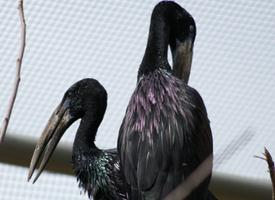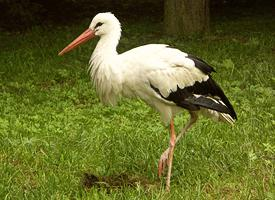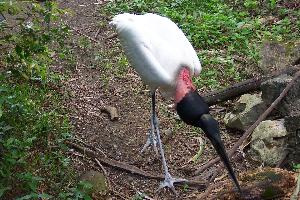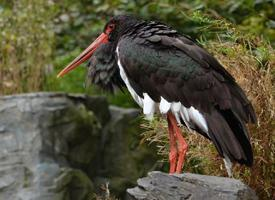
Descrierea animalului
The African Openbill (Anastomus lamelligerus) is a distinctive species of stork found in the wetlands of sub-Saharan Africa. This bird is particularly notable for its unique bill, which is unlike that of any other bird. The bill is long and has a gap between the upper and lower mandibles, which does not close completely even when the bill is shut. This specialized bill structure is perfectly adapted to its feeding habits, primarily focusing on aquatic snails and mollusks. The gap allows the bird to grasp and extract snails from their shells with remarkable efficiency, showcasing a fascinating example of evolutionary adaptation.Adult African Openbills stand about 80 to 94 cm tall, with a wingspan that ranges between 150 to 165 cm. Their plumage is generally dark with a glossy greenish or purplish sheen, which is particularly noticeable in sunlight. Juveniles, on the other hand, display a browner hue with less sheen than the adults. During the breeding season, adults develop a more striking appearance with white spots on their wings and backs, making them even more distinctive.
These birds are social creatures, often found in flocks. They are highly dependent on wetland habitats, including lakes, rivers, and swamps, where they forage for food. Their diet consists mainly of snails, but they will also consume small fish, amphibians, and aquatic insects. The peculiar shape of their bill plays a critical role in their feeding behavior, as it is specially adapted to extract snails from their shells, a task at which they are remarkably adept.
Breeding habits of the African Openbill involve nesting in colonies, often alongside other waterbird species. They construct large, platform-like nests in trees or reeds, where they lay clutches of two to four eggs. Both parents take part in incubating the eggs and feeding the young, demonstrating a high degree of parental care.
African Openbills are migratory birds, moving in response to the seasonal availability of their aquatic prey. Their migration patterns are closely tied to the rainfall patterns, which influence the abundance of snails and other food sources in their habitat. Despite facing threats from habitat destruction and degradation, particularly the draining of wetlands and pollution, the African Openbill remains relatively widespread and is not currently considered endangered. However, the conservation of their wetland habitats is crucial for ensuring their long-term survival.
In summary, the African Openbill is a fascinating bird species with a highly specialized bill that showcases the marvels of evolutionary adaptation. Its reliance on wetland habitats for feeding and breeding emphasizes the importance of conserving these ecosystems not just for the African Openbill, but for the myriad of other species that depend on wetlands for survival.
Animale similare
Fotografii noi cu animale
Top 10 animale
- Dolphin gull (Leucophaeus scoresbii)
- Diana monkey (Cercopithecus diana)
- Moustached guenon (Cercopithecus cephus)
- Galápagos tortoise (Geochelone nigra complex)
- Japanese macaque (Macaca fuscata)
- Stone loach (Barbatula barbatula)
- Russian tortoise (Testudo horsfieldii)
- Greek tortoise (Testudo graeca)
- Common flying dragon (Draco volans)
- Vendace (Coregonus albula)


